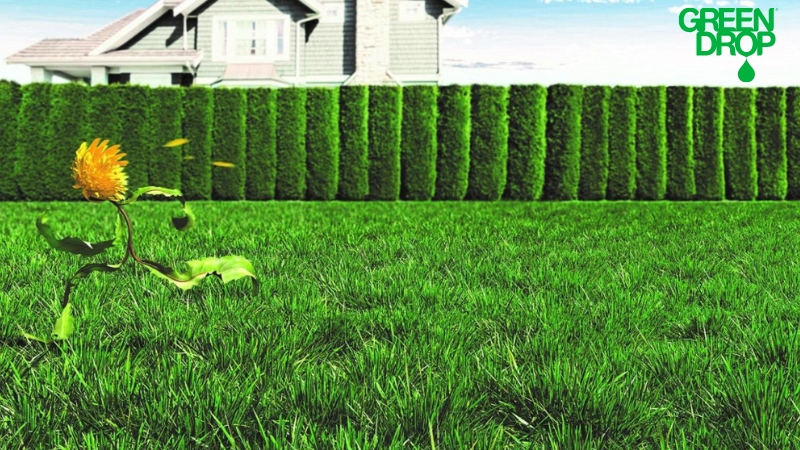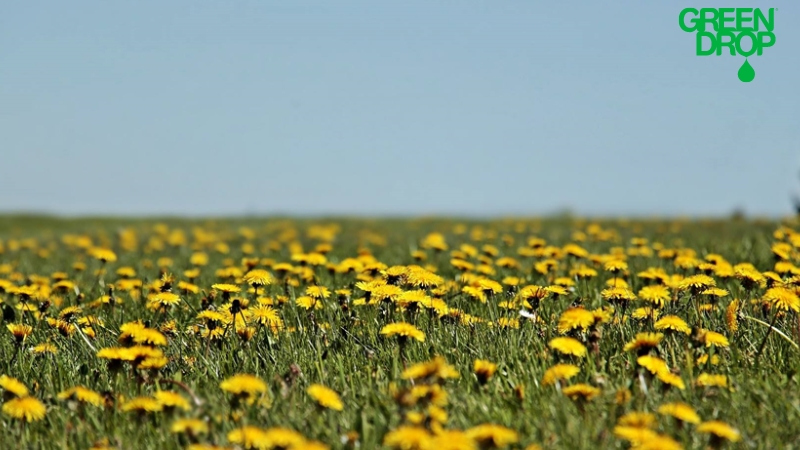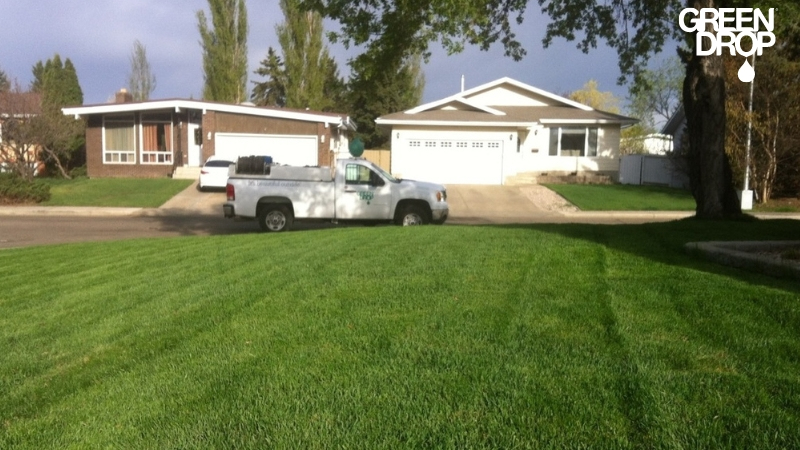Unlocking the Mystery of Dandelions—Their Impact on Your Lawn's Look and Feel
Reading time: 6 minutesYou’re enjoying the first warm days of spring when you see pops of yellow dandelions begin to speckle the green canvas of your lawn. They seem like a sign that spring is in the air, adding a splash of colour to the landscape.
But as these bright weeds multiply, they begin covering more of your lawn. Soon, they become a nuisance that just won’t go away.
Dandelions are stubborn like that. Their deep roots and rapid spread can quickly turn a lush, green lawn into a patchy, yellow-dotted battleground.

Dandelions—More Than Just Weeds
Dandelions, scientifically known as Taraxacum officinale, aren’t mere weeds. These perennial weeds feature deep taproot systems that penetrate the soil up to ten inches or more. They draw deeply buried nutrients and water to support their growth and make their removal a formidable challenge.
In the early spring, bright yellow flowers of the dandelion pop up to catch some sun, transforming into white puffballs as the season progresses. Each puffball, a seed cluster, relies on the wind to carry its seeds far and wide. A single dandelion can produce thousands of seeds, enabling it to colonize vast areas swiftly.
Dandelions thrive under different conditions thanks to their incredible adaptability and aggressive reproduction. They can emerge through tiny sidewalk cracks, invade well-kept lawns, and rapidly dominate disturbed soils. Their resilience primarily lies in their roots. If you don’t completely remove these, the plant can regenerate, even after cutting off or damaging the top.
The Science Behind the Damage
Dandelions aggressively compete with grass for essential nutrients, water, and sunlight. Their deep and extensive root systems allow them to access and deplete essential nutrients from the soil. This lack of nutrients can weaken the grass, leaving it prone to disease and less able to fend for itself.
On top of that, dandelions affect soil health and composition. Their roots can alter the soil's physical structure, sometimes improving aeration and drainage in compacted soils. They can also potentially disrupt the delicate balance of microbial communities essential for a healthy lawn ecosystem.
The presence of dandelions means that the soil condition favours their growth over that of grass, caused by imbalanced pH levels or compacted soil.
The dandelion's deep taproot extracts moisture and nutrients from deeper soil layers as well. This not only starves the grass but also leaves channels in the soil when it dies and decomposes. This can benefit soil structure but also allows for the rapid spread of dandelions by creating paths for new roots to follow.
More Than Meets the Eye

A lawn dotted with dandelions might look appealing at first. But once the weed spreads, the bright yellow flowers and the puffballs disrupt the uniform green canvas you want in your lawn.
Maintaining your lawn amidst a dandelion invasion is challenging, to say the least. The relentless spread and resilience of dandelions means you must be on your toes. You must put in time, effort, and resources to keep your lawn pristine.
Let's be honest; nobody wants to be the neighbour with the "wild" lawn, especially when it starts to look like a yellow polka-dot bedspread instead of that lush green carpet.
Dandelion Weed Control and Prevention Strategies
Controlling dandelions is more than just a springtime chore. It takes planning and strategizing to keep your lawn lush and vibrant. Here are some tactics that can help you outmanoeuvre these persistent invaders:
Mowing
Regularly mowing your grass to a healthy height (2.5 to 3.5 inches) is like setting up a sunshade against dandelions. Taller grass blades can overshadow emerging dandelion seedlings, hindering their ability to photosynthesize and grow.
Aim to keep your lawn at the higher end of its recommended height range. This not only discourages dandelions but also promotes a thicker, healthier turf that can withstand weed invasion and other stresses.
Watering
The trick to effective watering is to go deep but not too often. This method encourages your grass roots to dive deeper into the soil, developing a robust system that can access water dandelions can't reach.
A good rule of thumb is to water your lawn deeply once a week, providing about an inch of water each time. This schedule may vary with your soil type and weather conditions, so adjust as needed to keep your lawn hydrated without drowning it.
Improve Soil Health
Dandelions often thrive in compacted, poor-quality soil where grass struggles to grow. By aerating your lawn annually, you can relieve soil compaction, allowing air, water, and nutrients to penetrate more effectively to the roots of your grass.
Adding organic matter, such as compost, can also improve soil structure and fertility. Investing in the health of your soil not only discourages dandelions but also promotes a more resilient and vibrant lawn.
Overseeding
Introducing more grass seeds into your lawn can significantly increase grass density, leaving less room for dandelions. Choose a grass seed mix that's well-suited to your local climate and soil type to ensure the best growth results. Overseeding in the early fall or spring can help your lawn quickly recover from summer stress and reduce the likelihood of dandelion infestation.
Fertilizing
Nutrient timing is crucial. Applying the right fertilizer at the right time can give your grass the edge it needs to outcompete dandelions. Early spring and fall feedings with a balanced, slow-release fertilizer can boost lawn growth and health, making it less inviting for dandelions.
Mechanical Removal
When dandelions do appear, getting them out root and stem is critical. Tools like dandelion pullers or slender weeding knives are designed to remove the entire root without leaving fragments behind that can regenerate. This requires persistence and patience, especially in larger yards. On the other hand, it's a chemical-free way to reduce your dandelion population over time.
The Use of Herbicides
Combined with other methods, selective herbicides are excellent at targeting dandelions without harming your grass. Opting for eco-friendly and species-specific formulations minimizes the impact on the environment and non-target plants. If you’re working with herbicides, always check label directions, considering the weather and lawn conditions to maximize effectiveness and minimize runoff.
Weed Control Services
For those who'd rather not engage in DIY dandelion warfare, weed control services might be exactly what the lawn doctor ordered. Our GreenKeepers employ an integrated approach to dandelion control, combining cultural practices, precise herbicide applications, and tailored lawn care strategies. This comprehensive service ensures that your lawn remains a dandelion-free zone, preserving its health, beauty, and resilience.

Green Drop to the Rescue
Getting a grip on the dandelion invasion is crucial for both your lawn's health and its curb appeal. Those yellow dots spread quicker than gossip in a small town, and tackling them head-on keeps your grass in the green.
Don't let dandelions dull your lawn's sparkle. Ask the pros for help. Providing dandelion control services in Calgary, Edmonton, Red Deer, Regina, Saskatoon, and Winnipeg, Green Drop is your go-to for complete lawn care services.
Ready for a lush lawn without the hassle? Get an estimate, and let’s get started.

